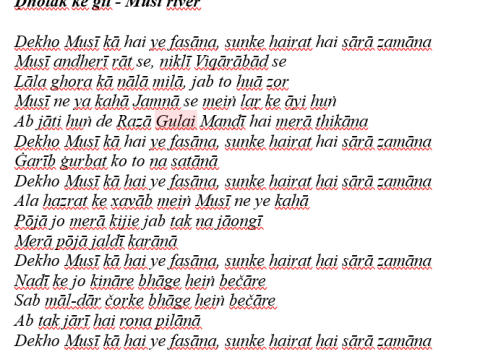Ḍholak ke gīt - Musi river
Dekho Musī kā hai ye fasāna, sunke hairat hai sārā zamāna is a ḍholak ke gīt (literally “the song of the drum”), a term designating a musical performance accompanied by a drum, performed on various occasions across the Indian subcontinent. In the southern regions of the Deccan plateau, ḍholak ke gīt takes on a distinctive connotation, referring specifically to songs sung by women in Dakhni language, the local idiom.
Ḍholak ke gīts, also known as Deccani folksongs, are of unknown authorship and date, and many questions concerning their origins, performance, context, and development remain unanswered. They are performed orally, and do not rely on written sources. The history of ḍholak ke gīts probably traces back to medieval times, when Sufis arrived in the Deccan and started writing religious songs to spread their teachings. During this period, most of these compositions are attributed to shaykhs of the Chishti Sufi order such as Amin al-Din A‘la (d. 1675) and Muhammad Gisu Daraz (d. 1422), who resided in the Deccan, and who were well-known personalities at the court of ‘Adil Shahi and Qutb Shahi dynasty in Bijapur and Gulbarga. Following the changes in women’s life in rural areas as well as the religious influence in the region, the Sufi songs fell into disused, and were incorporated into the vast corpus of gīt, which were performed in other regions across the Indian subcontinent.
Although they did never lose their religious significance, ḍholak ke gīts have developed over time, incorporating new themes and meanings, spanning from familial dynamics and festivities to societal and political concerns. Transmitted from generation to generation, from mother to daughter within the family circle, these songs have survived until today, and are performed across the Deccan region, especially at family gatherings and weddings. The repertoire of ḍholak ke gīts encompasses different stories, life experiences, and emotions, which are recollected, told, and shared within the community. Since they are performed by women alone, they enable us to delve into female consciousness, exploring their emotions, thoughts, and fears. Some instances suggest that these gīts not only serve as outlets for personal emotions and distress but also provide a platform for describing and discussing life events.
Deccani folksongs often feature localized references to historical sites, places, and the local language. An instance of their ‘hyper localization’ can be found in Dekho Musī kā hai ye fasāna, which narrates the flood of the Musi River in Telangana, South India, that occurred in 1918. The gīt is transformed into a captivating tale through the personification of the river. The flood, locally known as Thughyani Sitambar, shattered the life of Hyderabad’s residents, killing 50,000 people. In The Days of the Beloved, Harriet R. Lynton writes that the flood demolished over 80,000 houses, rendering a quarter of the population homeless. The magnitude of the disaster is vividly captured in the concluding lines of the gīt.
The local references to the Deccan region determine the specificity of this repertoire, which, besides providing a vivid portrayal of Dakhni and Hyderabadi life, serves as a bridge between the past and the present, highlighting the enduring vitality of oral traditions.
Ḍholak ke gīts - also known as Deccani folk songs (literally “the song of the drum”)
Shared by Maria Casadei, Studies on Cultures and Religions, Jagiellonian University, Poland
Musi River
Deccan Plateau
Hyderabad
Telangana
India

